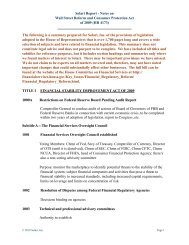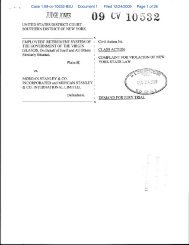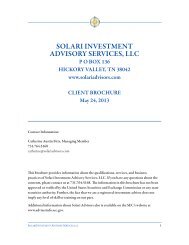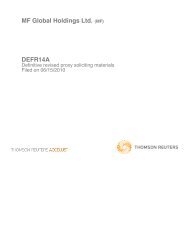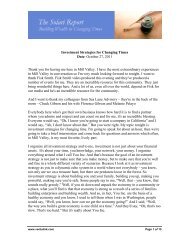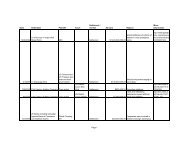Registration Statement on Form S-1 - Solari
Registration Statement on Form S-1 - Solari
Registration Statement on Form S-1 - Solari
You also want an ePaper? Increase the reach of your titles
YUMPU automatically turns print PDFs into web optimized ePapers that Google loves.
<str<strong>on</strong>g>Registrati<strong>on</strong></str<strong>on</strong>g> <str<strong>on</strong>g>Statement</str<strong>on</strong>g> <strong>on</strong> <strong>Form</strong> S-1<br />
Table of C<strong>on</strong>tents<br />
http://www.sec.gov/Archives/edgar/data/1318605/000119312510017054/ds1.htm#toc51863_17<br />
2/18/10 10:17 AM<br />
The range of our electric vehicles <strong>on</strong> a single charge declines over time which may negatively influence potential customers’<br />
decisi<strong>on</strong>s whether to purchase our vehicles.<br />
The range of our electric vehicles <strong>on</strong> a single charge declines principally as a functi<strong>on</strong> of usage, time, and charging patterns. For<br />
example, a customer’s use of their Tesla vehicle as well as the frequency with which they charge the battery of their Tesla vehicle can<br />
result in additi<strong>on</strong>al deteriorati<strong>on</strong> of the battery’s ability to hold a charge. We currently expect that our battery pack will retain<br />
approximately 60-65% of its ability to hold its initial charge after approximately 100,000 miles or 7 years, which will result in a<br />
decrease to the vehicle’s initial range. Such battery deteriorati<strong>on</strong> and the related decrease in range may negatively influence potential<br />
customer decisi<strong>on</strong>s whether to purchase our vehicles, which may harm our ability to market and sell our vehicles.<br />
The operati<strong>on</strong> of our vehicles is different from internal combusti<strong>on</strong> engine vehicles and may be unfamiliar to customers.<br />
We have designed our vehicles to minimize inc<strong>on</strong>venience and inadvertent driver damage to the powertrain. In certain instances,<br />
these protecti<strong>on</strong>s may cause the vehicle to behave in ways that are unfamiliar to drivers of internal combusti<strong>on</strong> vehicles. For example,<br />
we employ regenerative braking to recharge the battery in most modes of vehicle operati<strong>on</strong>. Our customers may become accustomed<br />
to using this regenerative braking instead of the wheel brakes to slow the vehicle. However, when the vehicle is at maximum charge,<br />
the regenerative braking is not needed and is not employed. Accordingly, our customers may have difficulty shifting between different<br />
methods of braking. In additi<strong>on</strong>, we use safety mechanisms to limit motor torque when the powertrain system reaches elevated<br />
temperatures. In such instances, the vehicle’s accelerati<strong>on</strong> and speed will decrease. Finally, if the driver permits the battery to<br />
substantially deplete its charge, the vehicle will progressively limit motor torque and speed to preserve the charge that remains. The<br />
vehicle will lose speed and ultimately coast to a stop. Despite several warnings about an imminent loss of charge, the ultimate loss of<br />
speed may be unexpected. There can be no assurance that our customers will operate the vehicles properly, especially in these<br />
situati<strong>on</strong>s. Any accidents resulting from such failure to operate our vehicles properly could harm our brand and reputati<strong>on</strong>, result in<br />
adverse publicity and product liability claims, and have a negative affect <strong>on</strong> our business, prospects, financial c<strong>on</strong>diti<strong>on</strong> and operating<br />
results. In additi<strong>on</strong>, if c<strong>on</strong>sumers dislike these features, they may choose not to buy additi<strong>on</strong>al cars from us which could also harm our<br />
business.<br />
Developments in alternative technologies or improvements in the internal combusti<strong>on</strong> engine may materially adversely affect<br />
the demand for our electric vehicles.<br />
Significant developments in alternative technologies, such as advanced diesel, ethanol, fuel cells or compressed natural gas, or<br />
improvements in the fuel ec<strong>on</strong>omy of the internal combusti<strong>on</strong> engine, may materially and adversely affect our business and prospects<br />
in ways we cannot anticipate. Any failure by us to develop new or enhanced technologies or processes, or to react to changes in<br />
existing technologies, could materially delay our development and introducti<strong>on</strong> of new and enhanced electric vehicles, which could<br />
result in the loss of competitiveness of our vehicles, decreased revenue and a loss of market share to competitors.<br />
If we are unable to keep up with advances in electric vehicle technology, we may suffer a decline in our competitive positi<strong>on</strong>.<br />
We may be unable to keep up with changes in electric vehicle technology and, as a result, may suffer a decline in our<br />
competitive positi<strong>on</strong>. Any failure to keep up with advances in electric vehicle technology would result in a decline in our competitive<br />
positi<strong>on</strong> which would materially and adversely affect our business, prospects, operating results and financial c<strong>on</strong>diti<strong>on</strong>. Our research<br />
and development efforts may not be sufficient to adapt to changes in, or create the necessary technology, independently. As<br />
technologies change, we plan to upgrade or adapt our vehicles and introduce new models in order to c<strong>on</strong>tinue to provide vehicles<br />
with the latest technology, in particular battery cell technology. However, our vehicles may not compete effectively with alternative<br />
vehicles if we are not able to source and integrate the latest technology into our vehicles. For example, we do not manufacture battery<br />
cells which makes us dependent up<strong>on</strong> other suppliers of battery cell technology for our battery packs.<br />
16<br />
Page 36 of 300



